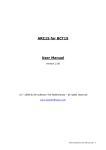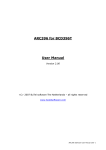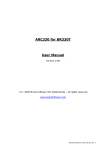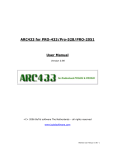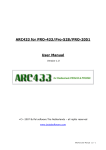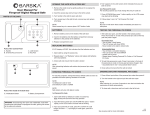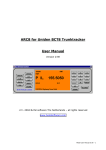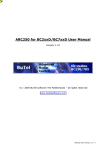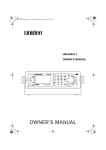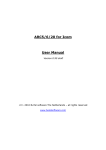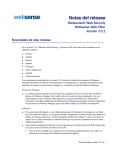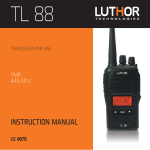Download Uniden BC246T User manual
Transcript
ARC246 for BC246T User Manual Version 1.10 <C> 2005 BuTel software The Netherlands – all rights reserved www.butelsoftware.com ARC246 Software User Manual 1.10- 1 Contents: 1 Introduction and quick start reference 1.1 Software Installation 1.2 Enter registration information 1.3 Connecting the scanner to your PC 1.4 RS232 port setup 1.5 USB information 2 Using and understanding the ARC246 editor: 2.1 Reading data from the scanner 2.2 General hints and tips for using the editor 2.3 How to Build a new system 2.3.1 System parameters 2.3.2 Trunk System parameters 2.3.2.1 Motorola VHF/UHF info 2.3.3 Programming trunk frequencies 2.3.4 Pasting Trunk frequencies from a website 2.3.5 Setting up groups in a system 2.3.6 Adding and Deleting Groups 2.3.7 QuickSave 2.4 Default Data 2.5 Sort data 2.6 Easy Fill 2.7 Using the clipboard 2.8 Copy/Move/Swap banks/channels 2.8.1 Copy/Move/Swap memory channels within a system 2.8.2 Copy/Move/Swap memory banks within a system 2.8.3 Copy/paste groups between systems 2.8.4 Copy/paste systems 2.9 Fill Down / Fill Series 2.10 Other editor options 2.11 Understanding how data is stored in Arc246 2.11.1 Viewing a Profile / create a profile 2.12 Organizing QuickKeys 2.12.1 QuickKey Overview 2.13 Uploading data in the scanner 2.14 Import/Export data 2.15 Software Bandplan 3 WebCatcher and TrunkWebcatcher 3.1 Using WebCatcher 3.2 Using TrunkWebCatcher 4 Scanner Configuration parameters 5 Virtual control 5.1 Keyboard shortcuts 5.2 Mini Display History 5.3 VC minimized 6 Misc. items 6.1 Troubleshooting RS232 communication problems 6.1.1 Set/Check communication settings 6.1.2 Check your cable 6.1.3 Other serial devices 6.1.4 Serial/USB drivers 6.1.5 Use ARC246 autodetect 6.1.6 Comm error 8018 6.2 revision history 7 FCC lookup utility 8 Radioreference Database Import Option ARC246 Software User Manual 1.10- 2 1: INTRODUCTION: ARC246 is a Windows software package for easy programming and controlling the Uniden BC246T. System requirements: • Windows 98/ME/XP/Win2000/NT • minimum display resolution settings: VGA 800x600 • display must be set to SMALL Fonts • Free serial port com1-com16 or USB to serial converter ARC246 Quick Start Reference: - Install the software (1.1) Enter the registration information (1.2) Connect the scanner to the PC (1.3) Setup the RS232 serial communication port number and baudrate using auto detect (1.4) IMPORTANT: YOU MUST ENTER A VALID REGISTRATION CODE TO MAKE FULL USE OF THE SOFTWARE. THE REGISTRATION CODE IS SEND TO YOU BY EMAIL (IF YOU PURCHASED ONLINE) OR IS IN THE CD BOX. DO NOT LOSE THIS INFORMATION; YOU NEED IT FOR UPDATES! Software limitations/ Important Information: ARC246 can open 200 systems at the same time. Per system you can open 20 groups. Per group (both trunk and conventional) you can program 200 channels. If you want to program more than 200 frequencies in a conventional system, use extra groups to store the frequencies. The BC246 can only store 200 channels in a trunk system. ARC246 can store more channels but the Bc246 will not accept more than 200 channels. You can program a maximum of 50 Trunk frequencies per system. ‘Empty’ channels are not sent to your scanner, so they do not waste space in scanners memory! ARC246 Software User Manual 1.10- 3 1.1 Software installation: The ARC246 is available as Internet download or on CD-ROM. Win2000/XP users: You must be logged on as administrator to install and use ARC246. Internet download: The downloaded file contains all the necessary files for installation. Run the exe file and the installer will automatically start. CD ROM: Insert the CDROM; the CDROM has an auto start option that will automatically start the installation process. If the installation process does not start, simply run setup.exe During the installation process you can set the installation directory. We suggest using the default directory. You cannot install the software on a network drive. Software un installation: ARC246 will automatically add an uninstall option. Use the Windows Control panel for uninstalling the software. Backup your work before using the uninstall option. 1.2 Registration: After installation of the software, the program runs in DEMO mode. You must enter a valid registration code to activate the software. Without valid registration the software will not upload data to the scanner. DEMO mode restrictions: - in demo mode you can upload 5 systems but only for a limited period when demo expires no systems can be send to the scanner Internet download: customers that purchased using the Internet download option, received a registration code by e-mail. It is VERY IMPORTANT that you store the registration code in a safe place. If you lose the registration information you must buy a new registration code. CDROM: in the jewel case of the CDROM you find the registration information. Store the case of the CDROM in a safe place. ARC246 Software User Manual 1.10- 4 Enter registration: Start the software by selecting START _ PROGRAMS _ Butel _ ARC246 _ ARC246 for Uniden BC246T. After the start screen, select HELP _ REGISTER in the menu. Enter the name and key information: the name is case sensitive! No spaces are allowed. The key only contains numbers. The name may contain ‘0’ (=zero) or capital O. 1.3 Connect your scanner: The scanner must be connected to a free serial port. This is normally a 9-pin connector at the back of your PC. Refer to your PC and scanner manual for information. BC246T: the BC246T comes with a serial cable; connect to a free serial port ARC246 Software User Manual 1.10- 5 1.4: Getting started: RS232 communication setup After installation of the software you must check and set the software settings for RS232 communication. Start the software and select: BC246T _ RS232 setup from the menu. The software has an auto detect option. If you know the settings for the serial communications port and baud-rate you can manually set them. Select OK and the software will store your settings. The software remembers these settings. If you do not know the correct settings you can use the software auto-detect option: - - - - Connect your scanner to a free serial comport (normally this is a 9 pin connector) using the cable that was supplied with the scanner Switch on your scanner, verify the scanner is enabled for RS232 serial communication: Press MENU , select ‘Xfer Information’ ‘PC Control’ and select 57600 and press E to store this setting. In the software press the auto-detect button, the software will scan all available serial ports and detect the scanner model and baud-rate. This autodetect process may take several minutes. If the software successfully detects the scanner, a message is shown, if the software does not detect the scanner check your cable and the scanner settings. Refer to section 8.2 for troubleshooting tips from our customer support department. The 57600 baud-rate setting is the preferred setting. Only use lower baud-rates in case of erratic communications. Choosing a lower baudrate then 19200 will decrease overall performance of the software. USB devices: Uniden scanners use the RS232 serial port standards. They do not support USB connections. BuTel does not provide any support for USB <> serial converters, use at your own risk. Any questions about a USB converter must be sent to the supplier of that device not to BuTel. ARC246 Software User Manual 1.10- 6 After setting up the serial communication you can check the connection. From the main menu select: BC246T _ Virtual Control. After a few seconds the Virtual control panel should show the contents of the scanner display. Below is an example (your ‘display’ will look different): ARC246 Software User Manual 1.10- 7 1.5: USB information Uniden scanners use a standard RS232 port for computer programming and control. Uniden scanners do not have a USB port available. Therefore ARC246 is developed to support standard serial comports. For laptop PC's that do not have a serial port we advise to use a PCMCIA serial port extender card. Several manufacturers also sell serial<>USB converters. These converters create a virtual software RS232 port and can work very unreliably. Because USB is not the standard computer interface port for Uniden scanners, BuTel does not support communication problems when a USB converter device is used. For support in case of communication problem customer should contact the supplier/manufacturer of the USB device. ARC246 Software User Manual 1.10- 8 2: Using and understanding the memory channel editor: ARC246 includes the most versatile memory editor available on the market. Unlike other software packages you can use ARC246 without a scanner connected. The main editor screen layout is divided into two panes, the left pane is called the ‘system browser’, the right pane is called the ‘channel editor’. For your convenience Windows style toolbars and right mouse click menu’s are available. This section describes most options available in the memory editor; in order to use the full power of the editor it is important that you read this section carefully. The editor does not require that a scanner be connected. The memory editor has a clear layout: ARC246 Software User Manual 1.10- 9 The top section has a standard Windows MENU bar and a Toolbar. Most options found in the menu also have a ‘shortcut’ in the toolbar. If the mouse is moved over a toolbar button a help text is shown giving a brief description of that button. The editor bar changes as you move the mouse in the editor grid, if you click on a column the editor bar will show the right edit options. You can edit data both in the editor bar or directly in the editor grid. Tip: In the Frequency/trunk ID and Name column you can enter edit mode by pressing F2 or double clicking a cell. 2.1 Reading data from the scanner: After setting up the communication you can start to use the memory editor. Because there is probably already some data in your scanner it is a good start to first read the data from your scanner. From the main menu select: BC246T _ Read Data. Tip: you can also use the toolbar button or press F5. A new window is shown: The software always starts with reading system information from the scanner. This information is required to read data from the scanner. If the software fails to read data, correct the problem and press ‘Connect To BC246’. ARC246 Software User Manual 1.10- 10 You can read all systems or selected systems. Make your selection in the list box by clicking the selection boxes. For your convenience, Select All and Unselect All buttons are available. In this window you can also delete systems from your scanner. Add System’s option: when this box is checked, the Arc246 browser will not be cleared and all systems you read from the scanner are added into the browser. Important: ARC246 can handle systems with the same ‘systemname’. But to avoid problems, it is best to only use unique system names. Memory indicator: In the status bar the current used BC246T memory is shown (0-100% scale) 2.2: Hints and Tips Once data is transferred to the memory channel grid you can use many options to edit your data. ARC246 is the most versatile editor available on the market. Using the menu or toolbar you can easily move/copy/sort data. All options also have a toolbar button available. Moving the mouse pointer over a toolbar button will show a small popup help text. You can edit data directly in the grid or you can use the editor bar. The editor bar will automatically change if you click on a column. Tip: In the Frequency/trunk ID and Name column you can enter edit mode by pressing F2 or double clicking a cell. This will show an edit box with cursor and the background color of the cell will change. In the frequency and tag columns you can directly type data, to edit existing data use the editor bar above the grid or press F2. Most columns support double click for easy data toggle. The space bar has the same effect as using the mouse double click. Sorting data: you can easily sort data in the Frequency/trunk id or name column by double clicking the header of those columns! Keyboard shortcuts: In some columns you can also use keyboard shortcuts: Mode: A=Auto, F=FM, N=NFM On/Off columns: 0 = OFF, 1=ON, F=OFF, N=ON. Spacebar: toggle data Although the editor can display ‘Empty’ channels, they are not sent to your scanner. ARC246 Software User Manual 1.10- 11 2.3 Build a new system: To build a new system select ‘FILE _ NEW’, this will add a new system to the systembrowser, in this sample screenshot New System 2 was added. ARC246 Software User Manual 1.10- 12 2.3.1 System Parameters Click the ‘New System 2’ line in the systembrowser to open the system parameter editor: First enter a unique name in the ‘System Name’ box. Select the System Type, depending on the systemtype, extra tabs are shown to setup trunk system parameters. Website: enter a website with information about this system. Pressing ‘Check Site’ will open the website. This website link is stored in your system file. System options: set the system options, refer to BC246T user manual for information. If the new system is a trunk system, additional parameters must be set, click the ‘trunk system parameters’ and ‘trunk frequencies’ tab to setup this data. IMPORTANT: before you start programming trunk id’s you must first setup the correct system type to avoid problems during data upload. ARC246 Software User Manual 1.10- 13 For your convenience, the system browser shows unique icons per system type: In this screenshot a conventional, a Motorola, a Edacs and a LTR systems are loaded. ARC246 Software User Manual 1.10- 14 2.3.2 Trunk system Parameters For every trunk system, several parameters can be set: Refer to BC246T user manual for more information. General: Motorola VHF/UHF: you must program a base, offset and step frequency (see next page). Motorola Type 1: for a Motorola type 1 a fleetmap must be selected or a custom fleetmap must be build. For a TYPE 1 system it is very important that the trunk system is setup correctly before any trunk id’s are uploaded to your scanner. Depending on the fleetmap settings the scanner may not accept some trunk id’s. Some Type 1 size codes require more then one block. If you enter size code 12 in block 0 the software will automatically set block 1 to size 12. You can only program size 12 id’s in block 0,2,4 and 6. Size Code 12 13 14 Required blocks 2 4 8 Blocks 0,2,4,6 0,4 0 ARC246 Software User Manual 1.10- 15 2.3.2.1 Motorola VHF/UHF systems: Explanation of base/step/offset parameters: For a type 2 VHF or type 2 UHF you must program base/step/offset parameters. For properly tracking a type 2 VHF/UHF system, the scanner needs channel number information. The tracking process is controlled by sending channel numbers instead of frequencies. Once the scanner knows one combination of frequency and channel number it will track the system because it can calculate all other frequencies using the step setting and the channel number it receives from the traffic channel. You must know at least one frequency used in the trunk systems AND the channel number assigned to that frequency. The step is normally predefined for the frequency range. Example: If the system you want to program uses a frequency 425.250 (step 25 kHz) and the channel number assigned to that frequency is 402 then you must program: Base: 425.250 Step: 25 Offset: 402 Because you know the step and channel number you can also use different settings, in the table below all given examples of base/step/offset will have the same effect: Frequency Step Offset Example 1 425.250 25 402 Example 2 425.200 25 400 Example 3 420.000 25 380 Example 4 430.200 25 600 The offset channel has a range of 380-600. ARC246 Software User Manual 1.10- 16 2.3.3 Trunk frequencies Click the Trunk frequencies tab to enter or paste trunk frequencies: The Name column is NOT sent to the scanner, this information is only stored in system files. For Edacs and LT systems the LCN number must be entered. Motorola systems do not use LCN information. ARC246 has a powerful option to ‘paste’ frequencies from popular websites like www.radioreference.com , see section 2.3.4 ARC246 Software User Manual 1.10- 17 2.3.4 Pasting frequencies from a website: While setting up trunk systems, you have probably spend a lot of time typing over frequency lists. ARC246 has a new paste option that will do this for you. First locate a website with trunk frequency information, in the sample we use a trunk system website found at: http://www.radioreference.com/modules.php?name=TRSDB&sid=3352 We want to copy the frequencies from this website into ARC246. ARC246 Software User Manual 1.10- 18 The first step is to highlight the frequencies at this website by holding down the left mouse button, then select CTRL-C or Edit _ Copy in your browser. (there are 24 frequencies used in this system) ARC246 Software User Manual 1.10- 19 Return to ARC246 and in the Trunk frequency editor click the right mouse button and select ‘paste frequencies’ and all frequencies are pasted in the grid: ARC246 Software User Manual 1.10- 20 2.3.5 Setting Up groups in a system After a new system is created you can setup the groups that belong to that system. In the systembrowser select ‘Edit groups’ from the right mouse button menu: In this window you setup Groups: First select the groups that you want to add to the system. This is done by clicking the ‘active’ box. A system can store a maximum of 20 groups. Important: Only data of ‘active’ groups is stored in a systemfile. If you disable groups, the data from that group is lost. Per group you can set a groupname, a Quickkey and the Lockout flag. Changing number of channels: In the main channel editor use the C+ and C- toolbar buttons to increase or decrease the number of channels per group. ARC246 will automatically adjust the number of channels when data is pasted in a group. Empty channels are not sent to the scanner. ARC246 Software User Manual 1.10- 21 2.3.6 Adding and Deleting groups from a system: Add a group to existing system: Once a system is created you can also add new groups using the system browsers right mouse button menu. ( Add Group). A system can only hold 20 groups. Systems can also be added in the Group Editor ( Setup _ Groups ), click the active option for groups you want to add to a system. Delete a Group from a system: Open the Group Editor ( Setup _ Groups ) and uncheck the ‘active’ option for groups you want to remove from a system. WARNING: If there is data is stored in that group, data is lost when ‘active’ is unselected! ARC246 Software User Manual 1.10- 22 2.3.7 QuickSave: Systems are stored in separate files. To avoid that you need to manually save all systems, a QuickSave option was developed. A system file can have a different filename than the systemname! In the ‘system’ editor the actual filename and location is shown. When you select QuickSave the software first checks if a filename already exists in the software (shown in system editor screen). If there is no filename stored, the software uses the systemname as filename (only first 16 characters). If systems have the same name, the filename is automatically modified so systems with the same name will not use the same filename. When you save a profile, the software will always first execute a Quicksave to make sure that all systems are stored in a file. ARC246 Software User Manual 1.10- 23 2.4 Default data: When you enter a frequency or ID and you press ENTER the other cells of that line are automatically programmed depending on your custom settings (default channel data). You can customize the default data: select SETUP _ SETUP DEFAULT DATA. A new window is shown: In this window you set the default data that is put in the grid when you press enter. All parameters that have the check box selected will be put in the grid. By using this option the software will take care of programming default data. Mode and step column: By default both step and mode are set to auto, so the scanner uses the internal database to lookup mode and step. Tip: programming your personal preferences in the default data and setup a custom bandplan will save you time while programming new frequencies/id’s. When you press <enter> the software will automatically go to the next cell. 2.5 Sort channels Memory channels can be sorted. You can either sort ascending or descending. You can only sort within a single group. In general scanners will scan faster when channels in a bank are sorted. Sort a range of channels: highlight the range of channels you want to sort, and then select the sort option. Only the selected range of channels will be sorted. ARC246 Software User Manual 1.10- 24 2.6 EasyFill EasyFill is a simple but powerful option that lets you program data in a range of channels with only a few mouse clicks. Additionally you can use EasyFill for quickly program a range of frequencies in a memory bank so you can use a memory as a search bank. Select EasyFill from the Options menu or use the EasyFill toolbar button to display the EasyFill window: In the top frame the channel range is selected. DEFAULT will set the start and end channel of the selected bank. ALL CHANNELS will set all 1000 channels. In the ‘Fill Range With’ frame you select the data you want to program in that range. If you want to set the mode for all selected channels to NFM select the MODE check box then select NFM and select APPLY, this will program WFM in all selected channels. You can select more than one check box. If the Frequency check box is selected you can set a start frequency and a step. The software will automatically calculate the frequencies for the selected channel range. Example: Frequency is set to 88.000 MHz, step is set to 50 kHz and channel range is 1-100. If you select APPLY the software will program 88.000 in channel 1, 88.050 in channel 2, 88.100 in channel 3 etc. ARC246 Software User Manual 1.10- 25 Fill series: for the TAG option you can also set the fill series option. Fill series will search for a number in the tag and use that number to ‘calculate’ the tags in the selected channel range. Example: in the tag box the tag is set to ‘Police 1’. The channel range is set to 1-100. If fill series is selected, the software will automatically program ‘Police 1’ in channel 1, ‘Police 2’ in channel 2, ‘Police 3’ in channel 3 etc. See also section 2.9. The number of characters of the tag box is shown in blue. ARC246 Software User Manual 1.10- 26 2.7 Using the clipboard In the memory editor grid you can use the standard Windows clipboard options. In the toolbar shortcuts are available for cut, copy and paste options. You can also use the keyboard shortcuts CTRL C, CTRL X and CTRL V. Use these options to paste data from other applications like Excel. An additional clipboard option is available that will automatically select entire lines (Cut line, copy line and paste line). To use these extra options, click any cell of a memory channel then select cut/copy/paste line. To paste in a different memory channel, select any cell in that memory channel, then select paste line, ARC246 will automatically align the pasted text. Important: while pasting data make sure the data is valid for the column you want to paste data. Example: you cannot paste WFM in the step column. 2.8 Copy/Move/Swap Memory channels / Groups Memory channels or entire groups can be easily copied, moved or swapped within a system. ARC246 Software User Manual 1.10- 27 2.8.1 Copy/Move/Swap Memory Channels: The ‘from’ and ‘to’ list boxes will automatically display the channel number, frequency and tag. Channels that are empty (no frequency programmed) are indicated as Empty. Current Bank: copy/move/swap channels in the active bank All Banks: copy/move/swap channels in all Banks 2.8.2 Copy/Move/Swap groups within a system: Use this window to copy/move/swap entire memory groups. The ‘Include Bank Tag’ options will also copy/move/swap the bankname. ARC246 Software User Manual 1.10- 28 2.8.3 Copy/paste groups between systems In the systembrowser you can copy/paste groups. Click on the group you want to copy and select the right mouse button. Select ‘Copy Group’ Next select the system where you want to paste the data, and select ‘Paste group’ in the right click menu. IMPORTANT: you can only copy/paste groups that are the same system type. So for example you can not copy a Motorola group into an Edacs system etc. 2.8.4 Copy/paste systems In the systembrowser you can copy/paste systems. Click on the system you want to copy and select the right mouse button. Select ‘Copy System’ Next select ‘Paste System’ and system will be added to the systembrowser. ARC246 Software User Manual 1.10- 29 2.9 Fill Down / Fill Series The Fill down and fill series options are used to copy the same data into a range of channels. Fill series will auto calculate ascending numbers in text tags (see examples below) This example will show fill down: Channel 10 contains Trunk=OFF, Delay Time = 4 seconds and Record =ON We want to copy this data to channels 11-20; first you must highlight the channel range: Now select the FILL DOWN option: ARC246 Software User Manual 1.10- 30 The software will automatically fill the selected range, using the data at the top of the selected range. Fill Series: Fill series only works in the tag column. It will look for number information in the tag and auto increase the number in ascending channels. Example: Channel 10 contains the tag ‘UHF Channel 431’: Highlight the channels where you want to copy the data to: Now select the FILL SERIES option and ARC246 auto calculates the new tags: ARC246 Software User Manual 1.10- 31 2.10 Other Options: PL/DPL Column : You can directly enter a CTCSS or DCS tone. The software will auto correct your entry. Tones that are entered and have a decimal are considered CTCSS tones. Tones without a decimal are DCS tones. Tips: You can scroll the list with subtones by using the - and + keys. Shift _ spacebar will scroll down. ARC246 Software User Manual 1.10- 32 2.11 Understanding how data is stored in ARC246 In ARC246 data is stored in a system file or in a profile file. System File: Stores a single system with all related parameters: - system settings, including systemname, systemtype, QuickKey and website. group settings channel data (either frequencies or trunk id’s and related channel parameters) Profiles: A profile stores a list of system filenames. When you open a profile, all system files that are stored in that profile are opened. So a profile does not contain system data, data is only stored in system files. You can view profiles by using the Profile Creator ( FILE _ Profile Creator ) Or you can open them as text file in Notepad. Creating a new profile: There are several ways to create a new profile: 1. Manually open all the systemfiles that you want to store in a profile. Every systemfile is added to the systembrowser. Use File Save Profile or File Save Profile As to store and create a profile. 2. Profile creator (see next item): With this utility you can browse your harddisk for systemfiles (.mem extension). The system files can be dragged and dropped into the profile. 3. read data from the scanner into the software and select FILE _ SAVE PROFILE AS. Saving a profile will automatically save your systems. ARC246 Software User Manual 1.10- 33 2.11.1 Viewing a Profile / Profile Creator: The Profile Creator makes it easy to create new profile, a profile is a collection of system files. A systemfile can be used in more than one system. Important: Since a profile only stores the location of a systemfile and NOT the actual data, be careful when you move mem files into different folders. Use the drive and folder navigation to locate system files (.mem) files. The lower part is the contents of the profile. - You can drag and drop system files into the profile. double clicking in the System Files section will copy a system file into the profile You can use Shift & CTRL buttons to make multi selections in the System Files list box. ARC246 Software User Manual 1.10- 34 ‘Import All’ will import all ARC246 mem files from the active folder (maximum is 200 files). You can also modify existing profiles, use the Open Existing PFL button to load existing profiles. Clean Up: if system files were moved to different folders you can use this button to clean up the profile. This option will check all files in the profile are still at their stored location. If they are moved, that system file is removed from the profile. ARC246 Software User Manual 1.10- 35 2.12 Organizing QuickKeys The BC246T uses QuickKeys to ‘combine’ systems so they can be scanned together. Also groups within a system can be assigned to a QuickKey. QuickKeys are numbers 1-9 and 0. In the systembrowser you will find the QuickKey Menu with powerful options to display, print and organize your QuickKeys. Displaying QuickKeys in the SystemBrowser: Press the ‘SHOW’ button and ARC246 will add all Quickkeys to the System and Group names in the systembrowser: In this sample screenshot you can see that ‘Nationwide CONV’ has system Quickkey 1 assigned and Group ‘CB channels’ has Group QuickKey 4 assigned within the system. Press ‘Hide’ to remove the QuickKeys from the systembrowser. ARC246 Software User Manual 1.10- 36 Within a system you can lockout groups, these groups will not be scanned even when the assigned Quickkey is selected. To indicate that groups have the lockout flag set a ‘L’ is displayed in the systembrowser: In this screenshot you can see that the ‘GMRS channels’ group has been assigned to QuickKey 2 but it has the Lockout parameter set so will not be scanned. The group ‘CB channels’ has not been assigned to a QuickKey but has the Lockout flag set. Group QuickKeys are set in the Group Editor. Select SETUP _ Groups in the menu to setup group names, QuickKeys and lockout flags. ARC246 Software User Manual 1.10- 37 2.12.1 QuickKey Overview: Click the ‘Overview’ button in the Quickkeys menu to show the Quickview Overview: This window will show per quickkey the systems or groups that are assigned to that quickkey: In the screenshot above you can see by Quickkey which systems are assigned to one of the quickkeys. You can also view the group quickkeys, in the ‘select’ dropdown list, select the system you want to see: You can simply use mouse drag and drop to move systems/groups into quickkeys. ARC246 Software User Manual 1.10- 38 2.13: Uploading data into the scanner: From the main menu select: BC246T _ Send Data Tip: you can also use the toolbar button or press F6. Empty channels are NOT sent to your BC246T. A new window is shown: You can upload ‘All Systems’ or ‘Selected’ systems. Make your selection in the system overview. Select All and Unselect All options are available. Upload options: ‘Clear All Systems first’ : this option will erase all systems that are stored in your BC246. It will NOT reset your scanner so ‘other’ data is not lost. ‘Overwrite Systems with same name’: select this option if you want to ‘replace’ systems. The software first reads the systems that are stored in your scanner. If systems in the scanner have the same name the software will first erase those systems and then upload the new data. Sending data can take up to 10 minutes. This is not a software limitation but a limitation of the scanners ‘dynamic memory management’. ARC246 Software User Manual 1.10- 39 2.14 Import/Export data: ARC246 can import data from various sources: - import using the clipboard: you can easily copy/paste data from Excel or other database software that supports the clipboard - import frequencies from text/html/csv files. Use the WebCatcher option to import from these files. ARC246 can export data: - CSV format: Select FILE _ Export CSV data , then select the data you want to export and ARC246 will create a CSV file - ARC246 fully supports the clipboard so you can copy/paste data from ARC246 into many other applications. ARC246 Software User Manual 1.10- 40 2.15 Modify the software bandplan. The BC246T has a build in Automode bandplan, this means that when you enter a frequency, the scanner will select mode and step from a preset list (see page 10-11 of BC246T user manual). ARC246 also uses this bandplan, by default mode and step of new frequencies are set to Auto. You can change this behaviour. In the systembrowser click on a conventional group. In the menu select SETUP _ BANDPLAN: Here you can modify the behaviour for a frequency range. Rules must be enabled before they are used by the software. The bandplan is stored and remembered. Rules are applied from top to bottom, rules can overlap. In this example the software will select ‘FM’ instead of ‘NFM’ for the 400.0 – 500.0 MHz range and 144.500 – 146.00 range. For your convenience the default bandplan is shown, in Auto mode this is the bandplan that is used, in this editor you program exceptions to the standard bandplan. ARC246 Software User Manual 1.10- 41 3.1 Using WebCatcher for importing frequencies from internet website: ARC246 can very easily import frequencies from any website. • • • • • • • • Start the ARC246 software Open you internet browser and open a website displaying frequencies you want to import (example: http://www.trunktracker.com) In your browser highlight the area you want to import: Now you must press CTRL - C in your browser (or select EDIT _ COPY from the menu) Now go to ARC246 and select FILE _ ADVANCED DATA IMPORT A new window is shown (see below) Now press the "IMPORT FROM CLIPBOARD" button. The software will now show the frequencies it found in the highlighted part of the website. ARC246 Software User Manual 1.10- 42 • ARC automatically removes duplicate frequencies: • For import into the memory table you must transfer the frequencies to the right list. Finally you select in what bank and at what channel you like to import the data. • • Press "EXPORT TO TABLE" button and frequencies are ready for upload! ARC246 Software User Manual 1.10- 43 • WebCatcher works with ANY website, the website shown above is only an example. Here is the result of WebCatcher (screenshot was taken from ARC250): ARC246 Software User Manual 1.10- 44 3.2 TrunkWebCatcher TrunkWebCatcher is a small but useful utility for importing trunk data from websites. You can import frequencies, trunk id’s and descriptions from websites in seconds! You can also modify data before you export or save. TrunkWebCatcher will convert selected text from a website (using the clipboard) into a grid. Depending on the filters you define, the data in the grid can be refined. Once an acceptable result is achieved, data can be copied to the clipboard for import into other software, or data can be saved in the general CSV format. CSV format files can be read by Excel. Your screen should be set to minimum of 800x600 but higher settings are recommended. There are some limitations in the software: - - the text that is copied onto the clipboard and imported in TrunkWebCatcher should not be too large. About 45000 characters is the maximum (this includes spaces!) the software assumes that a trunk id or frequency is at the beginning of a line. Websites that first show text information and than the id number will not work properly. To use the software follow these steps (see also detailed description with screenshots): - - locate a website showing the trunk data you are interested in, a good resource is www.radioreference.com start TrunkWebCatcher in your web browser, press and hold the left mouse button and highlight the area of the website you are interested in release the mouse button, and select EDIT _ COPY in the browser menu, or press CTRL-C at the same time, this copies the selected text onto the clipboard go to TrunkWebCatcher and press ‘Import from Clipboard’, the software will now copy the data into the grid refine the data using the filter options either save to disk or use ‘Copy To Clipboard’ to paste data into other applications, you simply highlight the area in the gird that you want to export. The save option saves the entire grid. Save: TrunkWebCatcher can save data in the CSV format. CSV format files can be read by Excel. Please note that in the beta version the entire grid is saved, not the selected area. ARC246 Software User Manual 1.10- 45 Columns setting: By default the software assumes the first part of the lines that are imported, are trunk id’s. If the data you copy has more columns, you can increase this setting so data is split into more columns. The space is used as separator. Just play with this setting to get the best result. Columns can always be combined or removed. General: importing large text from a website increases the possibility that data is lost by the filters, try to import text from a website that is grouped and has the same layout. ARC246 Software User Manual 1.10- 46 Filters: Because trunk id’s are normally just ‘numbers’, WebCatcher can not tell the difference between an id and other data. Therefore you must use filters. Experiment with these filters. As long as data is not copied back onto the clipboard, you can always go back to the original data by using the ‘Import from Clipboard’ option. Follow these 3 basic steps: 1: Import From Clipboard To Clipboard > 2: Filter data > 3: Copy Selection Once data is copied onto the clipboard, simply paste in ARC246. Filters are applied to the grid when you click the apply button. + Line must contain a number: This option checks if at least one number ( 0-9) is present in a line or row. If no numbers are present, that line is removed from the grid + Remove lines containing this string: Removes lines that match the string that is entered. The string is case sensitive. For example if you want to remove lines that only show frequencies, enter the decimal character ( . ) here and click Apply. + Remove lines NOT containing this string: Removes lines that do not match the entered string. The string is case sensitive. For example if you want to import Motorola type 1 id’s enter the character since these id’s (e.g. 122-34) always contain this character. ARC246 Software User Manual 1.10- 47 + Line must contain number of at least x digits: example when this is set to 3, a line containing 12-04-04 (could be a date) will be removed. Look at the website and increase this number if possible to get better results for Motorola systems. + Number must be dividable by 16: Most Motorola typ2 trunk id’s are dividable by 16. Check this option to improve results for mot 2 id’s. + Remove String: this option scans the whole grid and simply removes the string you enter. For example, if every line contains WFM or FM for mode setting, enter WFM and this info will be removed from the grid, strings are case sensitive. + Replace String: instead of remove, scan the whole grid and replaced the entered string, strings are case sensitive. Filter-tips: Motorola Type 1: type 1 ID’s normally have the format nnn-nn. To make sure the lines contain a Type 1 id, use a filter ARC246 Software User Manual 1.10- 48 Detailed Description and sample how to use the TrunkWebCatcher: Screen copy of a website showing trunk id’s / tags we want to import: (data source: Michigan State Police trunk system, at www.radiorefence.com) We want to import the trunk id’s and text from this website, first step is to highlight the section we want to import, you do this by holding down the left mouse button and move it over the section, your web browser will highlight the selection: ARC246 Software User Manual 1.10- 49 Now in your web browser you select EDIT _ COPY or simple press CTRL C , this will copy the selected text to the clipboard. ARC246 Software User Manual 1.10- 50 Go to the TrunkWebCatcher and select ‘Import from Clipboard’ : The text that you just highlighted is copied into the grid. Since the data at the website was divided into several columns, increase the ‘Split in Columns’ option to 4. ARC246 Software User Manual 1.10- 51 You will now see that the software divided the selected text back into the original columns: In this particular case the website already has a column called ‘Display’ . Because your scanner can only show a limited number of characters for the tag, the data from this column can be used to import into ARC246. The grid also shows a ‘long’ description but scanners can not store that. You can save the file with the long description to csv format for later reference. ARC246 Software User Manual 1.10- 52 You can use filters to remove unwanted data, although the grid can be easily used to copy data into your scanner software. In this example lines without numbers were removed: ARC246 Software User Manual 1.10- 53 Final step is to highlight area’s in the grid that we want pasted into other software, in this example we highlighted the column with trunk id’s and when you click ‘Copy Selection to Clipboard’ you can paste that into ARC246. ARC246 Software User Manual 1.10- 54 You can do the same for the display column: ARC246 Software User Manual 1.10- 55 Finally there may be websites that do not show descriptions that will fit your scanner, here is an example of using TrunkWebCatcher option to make shorter descriptions: In the Description column you see for example ‘Statewide District’ , you can replace this by ‘STW DIS’ or what you like: ARC246 Software User Manual 1.10- 56 And clicking Apply will give you: ARC246 Software User Manual 1.10- 57 4 Configuration parameters: From the main menu select ‘VIEW _ Configuration Editor’. If this option is not shown, click on a system in the system browser. You can edit BC246 configuration parameters like general settings, custom search ranges and SAME settings for WX alert. The current version of ARC246 does NOT save configuration data. If you want to edit these parameters read them from the scanner, modify them and send them back to the scanner. In the general settings tab you can enter a custom Opening Message: ARC246 Software User Manual 1.10- 58 5 Virtual Control ARC246 includes a virtual control option. Virtual control shows real-time scanner display data and you can operate the scanner from your PC keyboard using smart shortcuts. The history log will show recent activity ** (see next page for details). ** The log option in V1.01/1.02 may store false hits. The logger option will be improved in future versions of ARC246. When close call is enabled, Virtual Control will automatically display the found frequency! You do not need to press a key to display close call hits. ARC246 Software User Manual 1.10- 59 Information logged in the history log grid: Conventional Scan Mode : - System and Group Frequency Channel Name Time/Date Hitcount* IMPORTANT: In Conventional Scan Mode, Virtual Control will only log subtones that are found in sub tone search mode. Subtones programmed in channels are not logged, this is a limitation of the BC246T. Trunk Scan Mode: - System and Group - Frequency of trunkchannel - Trunk Id - Trunk ID name - Time/Date - Hitcount* Trunk Search Mode: - System and Group - Frequency of trunkchannel - Trunk ID - If trunk id is already stored in memory: Trunk ID name - Time/Date - Hitcount* Close Call: - Frequency found by close call Subtone Search: - Subtone detected * Hitcount is based on channel/group/system names. For correct operation of the hitcount make sure that all systems have a unique name. Also within a system, groups must have a unique name. Finally channels must have a unique name within a group. ARC246 Software User Manual 1.10- 60 5.1 Virtual Control: Keyboard Shortcuts When using your BC246T under virtual control, your PC keyboard has shortcuts to options in the BC246T : PC Keyboard button: Function: M Esc (escape) Arrow buttons up/down left/right H S Enter Open/Close BC246 Menu Open/Close BC246 Menu Browse BC246 Menu Hold/Resume scanning/searching Scan/Hold scanning/searching E button 1-9,0 Shift + 1-9,0 Select SYSTEM QuickKey On/Off Select GROUP QuickKey On/Off L U D Set Lockout Up Down Delete Clear entry ( frequency or trunk id) By using the ESC , Enter and arrow buttons at your PC keyboard you can easily browse the BC246 menu and set data 5.2 Mini Display: Double click in the VC main window to display a mini window ‘on top’. The position of the mini display is stored automatically. Double click the upper part of the display to restore VC to normal size. 5.3 VC minimized: If you minimize virtual control, your windows toolbar will display the first 2 lines of the scanner display (depending on space available): ARC246 Software User Manual 1.10- 61 6 General information and troubleshooting 6.1 Troubleshooting communication problems In case of communication problems you can use the information in this section to troubleshoot communication problems. 6.1.1 Set/Check scanner communication settings: Switch on your scanner, verify the scanner is enabled for RS232 serial communication: Press MENU , select ‘Xfer Information’ ‘PC Control’ and select 57600 and press E to store this setting. 6.1.2 Check your cable The BC246T comes with a special serial cable. Connect the cable directly to your PC serial port (9 pin male connector). If you use extra cables remove them and connect your scanner directly to your PC. Also check cable is properly plugged in the scanner. 6.1.3 Other serial drivers: If you also use the serial port for programming your PDA/PALM/POCKET PC or mobile phone (GSM), there may be resident software that constantly polls the serial ports. Disable any PDA/mobile phone programming software; they may interfere with the scanner serial communication. 6.1.4 Serial/USB devices: ARC246 does not support USB devices since the Uniden scanners only use RS232. Use a serial port connection using a PCMCIA or PCI option card. For USB support contact the supplier of the converter. If you use a USB converter, make sure you have the latest driver installed (available from manufacturers website). 6.1.5 Use the ARC246 Autodetect option: The ARC246 autodetect option has been well tested. Connect your scanner using the supplied cable, switch on your scanner and set serial communication to 57600 (see 6.1.1), and then select autodetect. 6.1.6 Comm error 8016: Communication error number 8016 will occur when other software is already controlling the selected comport. This error means that ARC246 can not get access to the selected comport usually because other software has control over the comport. Close the other software. ARC246 Software User Manual 1.10- 62 6.2 Revision history: ARC246 V1.00: release January 2005 ARC246 V1.01: release February 2005: New options/problems fixed: • • • • • • • • • • • • • • • • • • • • • • Modify software bandplan Better logging in conv. Mode VC shows frequency/System/Group Warning when duplicate frequencies are entered in trunk freq editor F2 ‘edit mode’ for freqs/id’s/names/sub tones Print system name when Qkeys are printed Remove/Find duplicates in all groups of system More messages when duplicates etc are not found Use shift + ctrl keys in Profile Creator mem list box Profile creator can import all files from selected folder Better support for USB converters Empty ‘custom’ search ranges are not uploaded to scanner Removed leading zero’s of frequencies and MOT2 trunk id’s Increased size of SAME name edit box Disable LCN column when Motorola system is shown Fixed mot vhf/uhf base/step/offset upload problem Fixed sort LT/Edacs problem Fixed export LT/Edacs problem Fixed copy/paste group problem Removed Undo button, undo is not implemented yet Updated Software Manual Updated Shortcut help ARC246 V1.020: release February 2005: • Bandplan option to modify default step/mode ARC246 V1.021: • • re-enabled minimize option for Virtual Control removed software debug message in system browser ARC246 V1.022: release March 2005: • • • • • Fixed custom search range problem Added support for special VHF frequencies in 7.5 step raster Software displays 6.25 step freq with extra digit Improved ‘step logic’ Software Manual version 1.01 ARC246 Software User Manual 1.10- 63 ARC246 V1.100: release August 2005 • • • Included RadioReference database reader New option to set preset Quickkeys Fixed misc. small bugs ARC246 Software User Manual 1.10- 64 7 FCC lookup ARC246 has a build FCC frequency lookup utility. You can directly search the online FCC database, press F3 to open the search window. First select a State and then enter the frequency. You can also directly check frequency data from the grid: - click on the frequency you want to check, in this example 476.5375, the frequency is shown above the grid in the editor bar. Press F3, the FCC lookup window is shown and the frequency is copied to that window. ARC246 tries to open your web browser and search the frequency. IMPORTANT: you must select the correct State first. ARC246 can only search one state. This setting is remembered. FCC lookup window: ARC246 Software User Manual 1.10- 65 And here is the result of the FCC search: ARC246 Software User Manual 1.10- 66 8 RadioReference Database import With ARC246 you can import trunk system data directly from www.radioreference.com , the largest scanner database in the world. For information about the database check out: http://www.radioreference.com/modules.php?name=RR IMPORTANT: To use the Radioreference import option you must sign up as a member and make a donation to Radioreference.com. In ARC246 select ‘INTERNET _ RADIOREFERENCE’ and the import window is shown: Enter your Username and password and press ‘CONNECT’. The software will now setup a link with the database. IMPORTANT: you must allow ARC246 to access the internet. Without access the import option will not work. Once connected to the database you can browse States, Counties and Systems to get the trunk system frequencies and Trunk ID’s from the database. You can use the ‘VIEW’ options to preview the data per State/County or System. ARC246 Software User Manual 1.10- 67 To import data, select at least one sites/System frequencies and one group with Trunk ID’s. Next press ‘Create System’ and system will be added to your systembrowser. Control Ch. Only: when you select this option, the software will only import control channel frequencies and the software will automatically enable the ‘Control Channel Only’ mode for the selected system. If the radiorefence.com import option does not work, check the following: • • • • make sure your username/password is valid. Go to www.radiorefence.com and logon to check your username/password are valid you must be a donating member. Information at http://www.radioreference.com/modules.php?name=Content&pa=showpage&pid=23 if you are not a donating member the software will show an error message. Disable your firewall, if this restores access to the database you must reconfigure your firewall so ARC246 is allowed to access the internet ARC246 Software User Manual 1.10- 68




































































